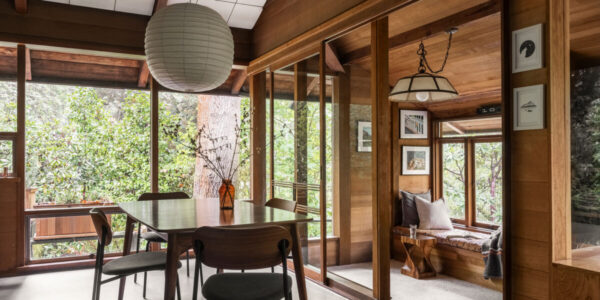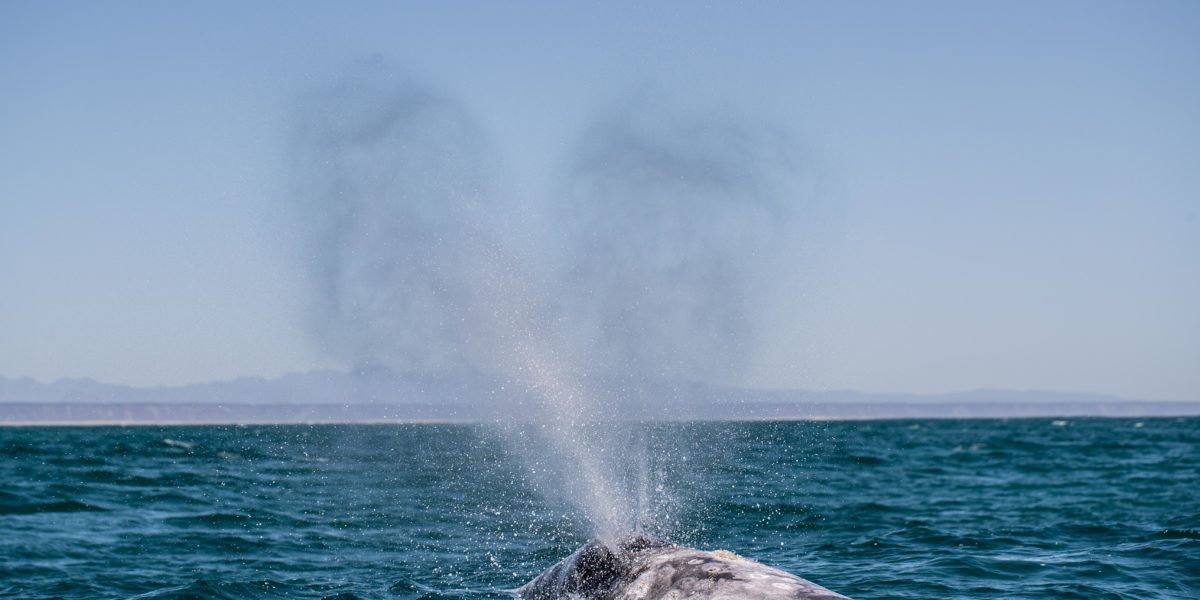
The Whales of Baja
Start the new year with a change in scenery that will change your life: a cruise full of activities, and nature at its grandest, in the Sea of Cortez

“We’ve got a whale!”
Naturalist Pete Pederson’s heads-up is what everyone’s beenwaiting for all day, and I win the first spot with him, thanks tosome dogged looking on my part; he’s the expert, but I throwcaution to the wind, and add, “There are two ― one larger andone smaller.” Peering through his binoculars, Pederson immediatelyconfirms it; a large spout, and then a smaller one, hang in the airfar out on the horizon.
I’m onboard the M/V Sea Bird, on an eight-day guided nature expedition of theBaja California peninsula’s waters, cruising both the Sea of Cortezto the east and the Pacific to the west. As the first whales of thetrip approach, passengers scramble to the front of the ship, firingup cameras and camcorders, shouting with every new exhalation.Pederson and his fellow staff naturalists explain how to use theclock method to identify positions of spouts (12 o’clock straightahead, 3 o’clock directly right, and so on) and soon identify ourvisitors as the second largest animal species in the world ―fin whales, mother and calf.
When they pass, we turn about, into the wind, to accompany them.I’m perched on a small seat built into the inside of the prow,leaning out over the water as our ship dips and soars. The whaleslabor against the waves with incredible power, scattering them intospray; I’m in awe of the mother’s size when I realize how much ofher, like an iceberg, is still below the surface. I don’t botherwith my camera: No photograph, no film, can ever capture theexperience of seeing a whale in the wild. And it couldn’t be bettertimed than the start of a new year: being reminded what the worldhas to offer when you take time to notice; rediscovering what youcan see when you really look.
Jump to our list of whalewatching outfitters
Off the shores of Baja, cold, nutrient-rich waters rise from deepbasins to meet the sunlight, creating a rich broth of plankton.That makes a good seasonal home for marine life, including some 875species of fish and 20,000 California gray whales that make anannual trek of up to 10,000 miles from the Bering Sea and the northPacific Ocean to breed and calve.
It’s one of nature’s greatest shows on earth, drawing thousandsof visitors ― and a phalanx of local and international guides― each winter. Our 152-foot ship, operated by longtimeoutfitter Lindblad Expeditions, is large enough to hold the trip’s51 guests plus crew in comfort (as well as a flotilla of inflatableZodiacs). But it’s small enough to provide some sense of intimacywith the surroundings, including access to areas where no cruiseship could go.Despite the number of whales that congregate in the Sea ofCortez, it’s still a big place. Most of Sunday, our first day atsea, is spent spotting birds, not whales ― dark storm petrelsskimming the waves, brown pelicans locked in formation, gracefulfrigate birds soaring high above ― as we make our way to ourfirst stop, Isla San Francisco, for hiking and kayaking.
We break into three groups based on difficulty of hike, and Ijoin the ambitious troop following veteran marine biologist andnaturalist Larry Hobbs, who spent a career researching the lives ofwhales and marine mammals before leaving the frustrations of thegrant chase behind. It’s more of a ramble than a hike, really, since there are noreal trails to speak of: “Where to now, Larry?” “Well, uhh, I think we’ll go over up that way maybe, make ourway up toward that rise …” We learn to recognize different cactus, are shown easilyoverlooked wood-rat dens, visit with a young chuckwalla lizard thatseveral of us nearly stepped on, and get in a good scramble on theway up to one of the tallest points on the small island. It’sbuffeted by strong gusts, but offers a sweeping vista: to the left,the Baja peninsula’s Sierra de la Giganta, rugged mountains clearlycreated out of the epic violence of geology, if not the battlinggiantess of myth; blue Canal de San José stretching northward;and at right, Isla San José, with an emerald peninsula juttinginto the canal. My normal life suddenly seems far away, and itfeels like if I only lift my arms, the winds of the Sea of Cortezcould bear me anywhere. We continue south overnight, and arrive at Los Islotes, at thetip of Isla Partida, Monday morning. Some 200 California sea lionslive on these rocks this time of year, and they’re habituatedenough to Zodiacs full of camera-toting tourists that olderresidents merely keep an eye on us while the young cavort aroundthe boats like curious puppies. And snorkelers, as I’m about tolearn, are entertainment.I slip into the cold water from the bobbing craft and kick away,and am amazed at the amount of sea life teeming just below us.
“The Gulf of California offers the best diving and snorkelingyou’ll find outside tropical waters,” says Lindblad naturalistCarlos J. Navarro, a biochemical engineer specializing in marinebiology who has lived on the shores of the Sea of Cortez for mostof the past 18 years. I follow damselfish and sergeant majors,darting about in schools. King angelfish, violet with yellow tails,and thin-striped convict tangs, rarely seen in this area, drift by.Patrols of surgeonfish, protected by razor-sharp blades protrudingfrom their tails, idly browse the seaweed. But then I get that feeling of being watched myself, and 10yards away to my right, I see a big adult sea lion, illuminated inthe light from above, casually drifting in the opposite direction.With a flick of his tail, he disappears into the gloom, andsuddenly, as if an OK sign has been given, juvenile sea lionsappear out of nowhere, everywhere, flashing past, and as I liestill, circling me and nibbling my flippers. A sea lion shoots directly at me, not swerving away until he’s awhisker’s length from me, and I flinch. Within a few minutes,another pup leaves his mother’s side to pull the same trick ―only this one I see coming from at least 15 yards away, so it’slike being tracked by a torpedo. There’s nothing threatening abouttheir behavior; it feels more like being toyed with. “I don’t know what makes someone a sea lion magnet,” says Hobbswhen I climb back into the Zodiac, “but you’ve got it.” There’s noespresso strong enough to get me feeling as buzzed as I am rightnow. After a day of snorkeling and bird-watching at the southernmost endof Baja, in Cabo San Lucas, I begin Wednesday morning with what’sbecome my usual routine, making a quick visit to the bow to checkfor any whales before picking up a prebreakfast latte to-go down inthe lounge. Pete Pederson and Lindblad veteran guest Jean Pitts arewatching a flock of birds spooling over a patch of water. Whales?As the Sea Bird veers toward it, a dolphin fin breaks the surfaceof the water, then another, and another, all cutting their waytoward the ship. Soon Pitts and I are leaning over the bow, watching a pod ofcommon dolphins ride the pressure wave. They are so close, we canhear them expel when they breathe. She’s from Dallas, I’m fromCalifornia, and some 35 years separate us ― but I glance upat her watching the dolphins, and the look of delight on her facematches my own. We sail into Bahía Magdalena, at 60 miles long, one of thelargest bays on the West Coast. Early in the season, its entranceis a hot spot for mating whales, but the only action we catch is acouple of groups of gray whales and the curious sight of a sea lionfloating along with its flipper in the air (to cool off or warm up,according to Hobbs ― everyone should have a naturalist athand).In the afternoon, we take on a local pilot and his apprenticeson to negotiate Hull Canal, a narrow mangrove-lined waterway onthe north end of Bahía Magdalena that will lead to ourultimate destination: the lagoon in Boca de Soledad, which is a”nursery” for gray whales. Bottlenose dolphins surf the bow wavefor a while, and we see a wealth of birds: blue heron, great andsnowy egret, long-billed curlew, whimbrel, and ibis.
The mangrove forests eventually give way to low-slung dunes,which come alive in golden whorls and dark shadows in the low lightof dusk. From the crest of a dune, two coyotes watch us pass beforetrotting away to the evening’s business. Our first full day in Boca de Soledad is spent following graywhales from a respectful but still breathtakingly close distance inthe Zodiacs, leaving alone one pair that appear to pick up theirpace when we start to follow. Then we celebrate our cruise drawingto a close with help from some locals ― a buffet dinnercatered by the restaurant Ballena Gris (“Gray Whale”) and music bya guitar-wielding trio from the town of Puerto LópezMateos. Later, I take a wool blanket from my cabin to lie on thedeserted bow and watch the stars slowly wheel. But soon I’m nolonger alone. The whales sigh as they rise from the waters of themouth of solitude. The sounds of their spouting can travel far overstill water at night, but after days of searching, watching, andlistening, I know they’re swimming close by ― one to port,and an adult and calf to starboard. I stand at their arrival,peering into the night. And I notice something I’ve missed: Everyfew minutes, pelicans glide by, silent and just above the water,passing the ship like spirits in the dark.Before Friday’s sunrise, we slip away from the Sea Bird in our Zodiac and motor out onto a sweep of glassreflecting a gray sky. After spotting a few spouts (we’re allgetting pretty good at it), and following an adult around for awhile, we tag along with a mother and calf. A few minutes pass,then they suddenly stop swimming. The mother goes still, floatingat the surface and possibly nursing. Pete Pederson idles theengine, and we bob nearby, watching the calf swim and roll aroundits parent, acting like any bored kid.
Laguna San Ignacio farther north may be a more populardestination (it’s the home of the “friendly whales”), but itscrowded Pet-A-Whale! environment is very different from here, whereour handful of Zodiacs and the Sea Bird are the only boats around. “That was so great tosee whales just going on about their lives,” Pederson says, as thepair dive from view. Pederson, along with his wife and co-naturalist, Gretchen, andtheir comrades are an inspiring lot in this new year. Theenthusiasm and passion they exude for their work never seems toebb; from their reactions, you’d think it was the first humpbackwhale or blue-footed booby they’ve seen, rather than thethousandth. At dawn on Saturday, we wake near San Carlos and sleepily boardbuses in the harbor for a quiet ride across the narrow peninsula tothe modest La Paz International Airport. Our chartered AeroMexicoflight lifts off, and the Bahía de La Paz is soon below. Isigh as we rise, the ripples on the bay giving way to the biggerpicture of currents and gradations of blue and green. The boatsplying these waters are tiny now. But I’m searching intently,greedily, not letting go. And then, at 1,200 feet, with the world growing beneath us, I’mrewarded. It could have been like many moments that slip past us:the smallest puff of mist that dissolves into a transient yettelltale mark upon the water. But I turn to the Pedersons acrossthe aisle, who are, like the others, already absorbed in somethingelse entirely: “Hey, Gretchen ― I got a spout at 3o’clock!”They laugh, and Pete, nearest the window, can’t help taking onemore look.
| Back to top Cruise Baja
Whale-watching season in Baja hosts outfitters large and small,local and international. Do you want an afternoon spent in a small panga in Laguna San Ignacio, guided by a local, with a highchance of actually touching a whale, or do you want to spend thetime and money to see a wide range of sea life and terrain in anall-inclusive experience? Here are four outfitters with solidreputations. Prices include tours, meals, and accommodations. American Cetacean Society. 12-day expeditions Feb-Apr,embarking from San Diego. $3,275; www.acsonline.org or310/548-7821. Ecoturismo Kuyima. Outings into the San Ignacio Lagoon WhaleSanctuary in a small motorboat are staged Feb-Apr from thecompany’s cluster of thatch-roof, two-person huts at the edge ofthe preserve. From $495; www.kuyima.com or 52-615-154-00-70. Lindblad Expeditions. 8-day expeditions embarking from LaPaz, Mexico. “Baja: Among the Great Whales” ’07 runs mid-Jan–Mar.From $3,990; www.expeditions.com or 800/397-3348.Oceanic Society. 12-day expeditions, embarking from SanDiego. $3,090; www.oceanic-society.org or 800/326-7491.
